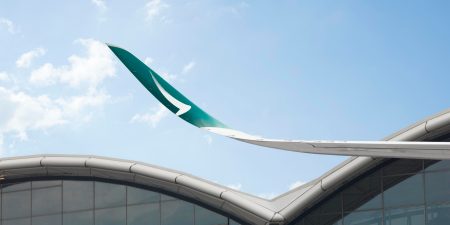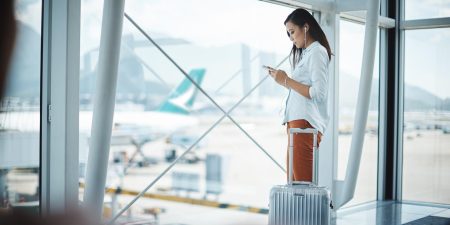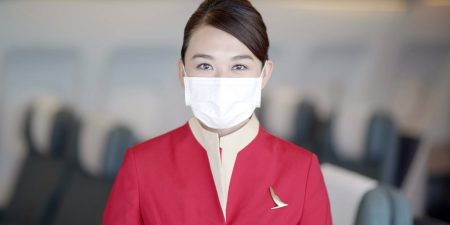
Cathay Pacific sends final aircraft home from Alice Springs
Cathay Pacific’s last aircraft stored during the pandemic leaves the Australian desert and marks an exciting step in its rebuild journey
On 6 June, Cathay Pacific celebrated the completion of its time at the Asia Pacific Aircraft Storage (APAS) maintenance facility in Alice Springs with its final aircraft taking to the skies after nearly four years.
The last aircraft to leave, an Airbus A330, was the first of 76 aircraft to enter the storage facility on 28 July 2020 after the unprecedented pandemic forced Cathay Pacific to ground the majority of its passenger fleet.
The closing of this chapter in Alice Springs signifies a huge step forward for Hong Kong’s home carrier as it plans to rebuild its passenger flights to 100% of pre-pandemic levels within the first quarter of 2025.
Frosti Lau, Regional General Manager, Southwest Pacific said: “This is a special moment, not only for the team in Australia, but also the brand. Cathay Pacific continues to regrow its network and flights, and this was the final piece in getting all our aircraft back in the sky. It has been incredible to witness the team’s dedication to achieve this”.
Preparation
After determining that its full fleet could not stay long term at Hong Kong International Airport (HKIA) during the pandemic, Cathay Pacific identified Alice Springs as the ideal location for its aircraft. This was due to its low humidity, far proximity to the ocean and on-site maintenance capabilities. Accompanying the 76 aircraft to the desert were a team of five Cathay engineers to provide oversight and support to over 100 on-site engineers and mechanics who were dedicated to maintaining the fleet in these unique desert conditions.
During the first two weeks in Alice Springs, the engineering team were required to undertake a series of preservation tasks to prepare the aircraft for long-term storage. This included draining engines of their oil and refilling with corrosion inhibiting fluid, treating fuel tanks with a solution to avoid microbiological growth, sealing of windows, doors, sensors, and openings to protect from dust and debris, and removing sensitive components for storage in a temperature-controlled environment.

Ongoing maintenance
To continue to keep the fleet in good condition, periodic checks where completed. The periodic checks consisted of packages undertaken at 7 days, 14 days, 30 days, 60 days and continued up to 2 years. Each interval required a different volume and depth of maintenance.
Reactivation
Once a plan was set out for reactivation, the team in Alice Springs worked alongside our Hong Kong-based engineers to start this complex process. Each reactivation required a 6-month lead time for working with the aircraft manufacturer to carry out a technical assessment, and every aircraft had a tailored package of maintenance tasks developed.
This was followed by 1-2 months of extensive reactivation work in Alice Springs. The tasks included landing gear swings, engine runs, structural inspections, lubrication tasks and functional tests of all the aircraft systems and components. Once reactivated and declared safe for flight, each aircraft was then ferried back to Hong Kong where it would then undergo a further extensive scheduled maintenance check in a hangar facility.
Since July 2020, the team on site has:
- Performed 16,000 periodic checks to ensure the airframe, engines, systems, and components remained in top condition
- Spent approximately 800,000 labour hours performing periodic and reactivation maintenance
- Conducted more than 2,000 oversight surveillance checks through the Quality Assurance on-site standards team
- Shipped over 40,000 parts to Alice Springs from components, tooling and even a set of aircraft jacks and specialist ground support equipment

Adam Nelson, Regional Head of Engineering, Southwest Pacific said: “I am immensely proud of the team of engineers who have worked in Alice Springs over the last four years as well as those who assisted from our head office in Hong Kong. It has truly been a team effort requiring the support of our airline planning and flight operations teams, as well as key partners including the Hong Kong Civil Aviation Department, HAECO, Boeing, Airbus and APAS.
“The focus throughout has been on ensuring our aircraft were meticulously maintained in top condition whilst in storage, and then safely reactivated for its ferry flight back to Hong Kong. The fact that every aircraft reactivation, hangar check and subsequent entry back into service has been safe and smooth is testament to the hard work, care and attention the team has put in over the last 4 years and is a phenomenal achievement.
“We had team members literally move themselves and their families to the desert or even come out of retirement to help with this once-in-a-lifetime project and their dedication has been extraordinary”.

Following the last flight, the Cathay team based in Alice Springs will spend the next couple of months finishing their activity on-site and preparing for their own flight home.









